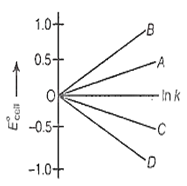 Multiple Choice Questions
Multiple Choice QuestionsGaseous benzene reacts with hyodrogen gas in presence of a nickel catalyst to form gaseous cyclohexane according to the reaction,
C6H6 (g) + 3H2 (g) → C6H12 (g)
A mixture of C6H6 and excess H2 has a pressure of 60 mm of Hg in an unknown volume. After the gas had been passed over a nickel catalyst and all the benzene converted to cyclohexane, the pressure of the gas was 30 mm of Hg in the same volume at the same temperature. The fraction of C6H6 (by volume) present in the original volume is
1/3
1/4
1/5
1/6
Given, G°=-nFE°cell and G° = -RT ln k. The value of n = 2 will be given by the slope of which line in the figure

OA
OB
OC
OD
Consider the following changes
M(s) → M(g) ... (1)
M(g) → M2+(g) + 2e- ...(2)
Mg) → M+(g) + e- ...(3)
M(g) → M2+(g) + e- ...(4)
M(g) → M2+ (g) + 2e- ...(5)
The second ionisation energy of M could be determined from the energy values associated with
1 + 2 + 4
2 + 3 - 4
1 + 5 - 3
5 - 3
The ratio of slopes of Kmax vs V and V0 vs v curves in the photoelectric effects gives (v = frequency, Kmax = maximum kinetic energy, v0 = stopping potential)
the ratio of Planck's constant of electronic charge
work function
Planck's constant
charge of electron
The dissolution of Al(OH)3 by a solution of NaOH results in the formation of
[Al(H2O)4(OH)2]+
[Al(H2O)3(OH)3]
[Al(H2O)2(OH)4]-
[Al(H2O)6(OH)3
If the ionisation energy and electron affinity of an element are 275 and 86 kcal mol-1 respectively, then the electronegativity of the element on the Mulliken scale is
2.8
0.0
4.0
2.6
Consider the water gas equilibrium reaction,
C (s) + H2O (g) CO (g) + H2 (g)
Which of the following statements is true at equilibrium?
If the amount of C(s) is increased, less water would be formed
If the amount of C(s) is increased, more CO and H2 would be formed
If the pressure on the system is increased by halving the volume, more water would be formed
If the pressure on the system is increased by halving the volume, more CO and H2 would be formed
For the given reaction,
H2 (g) + Cl2 (g) → 2H+ (aq) + 2Cl- (aq); = -262.4 kJ
The value of free energy of formation () for the ion Cl-1 (aq), therefore will be
-131.2 kJ mol-1
+131.2 kJ mol-1
-262.4 kJ mol-1
+262.4 kJ mol-1
The molarity of NO3- in the solution after 2L of 3M AgNO3 is mixed with 3L of 1M BaCl2 is
1.2 M
1.8 M
0.5 M
0.4 M
A certain metal when irradiated by light (r = 3.2 × 1016 Hz) emits photoelectrons with twice kinetic energy as did photoelectrons when the same metal is irradiated by light (r = 2.0 × 1016 Hz). The v0 of metal is
1.2 × 1014 Hz
8 × 1015 Hz
1.2 × 1016 Hz
4 × 1012 Hz